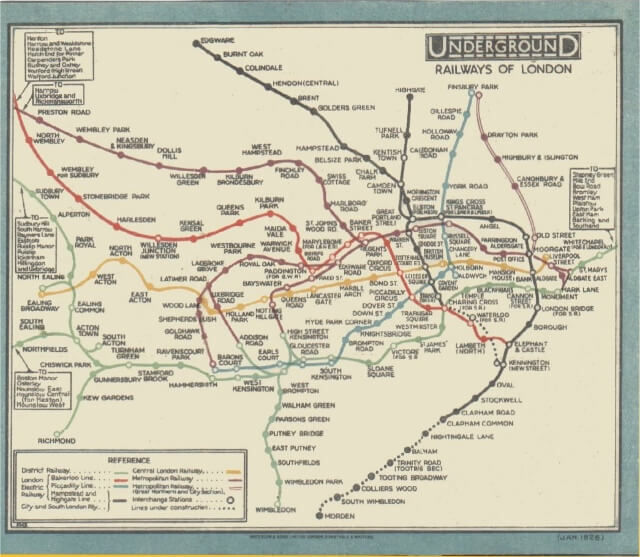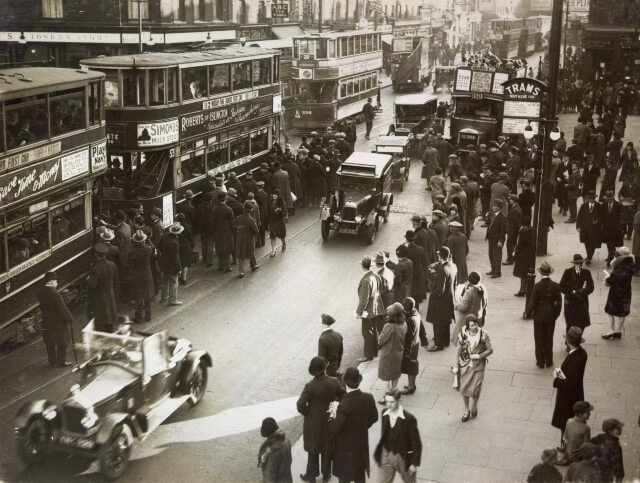We take it for granted today that from the more northerly reaches of the HHS district it can take under thirty minutes to get to central London by tube. This was not always the case.
The first section of the Piccadilly line from Hammersmith to Finsbury Park opened on 15 December 1906, with a branch line from Holborn to Aldwych opening less than a year later. In other directions, the network had been built as far as Watford in 1917 and Ealing in 1920 and despite growing agitation for a tube line north of Finsbury Park, construction didn’t start until 1930. Why did it take so long ?
Early development of the Underground
The London Underground had evolved in a piecemeal way since its beginnings in 1863 when the Metropolitan Railway opened between Paddington and Farringdon Street. The original concept of a network of underground tramways connecting central London locations soon evolved into something broader and by the beginning of the twentieth century the network was expanding. Lines developed, owned by different private companies and while these were sanctioned by Parliamentary Acts there was no over-arching plan. A unified interconnecting system wasn’t established until 1933 when a statutory body, the London Passenger Transport Board was set up to oversee the network.

Congestion at Finsbury Park
Agitation for a tube line running north of Finsbury Park began in 1919 because of the growing problem of congestion around the station there at street level. This was caused by commuters exiting in order to travel onwards to their homes in Manor House, Harringay, Wood Green and beyond. In order to complete their journeys, people were required to exit the two lines that terminated at Finsbury Park, the Piccadilly and the Great Northern and City Railway (GNCR), and cross a very busy Seven Sisters Road to board a northbound bus or tram. As the numbers of passengers increased, the congestion at street level got worse and worse.

Again, because this was prior to the formation of the London Transport Passenger Board, there were different companies running the bus and tram routes and sections of the road were owned by others. There was no co-ordination between these groups to ensure an orderly flow of people and the ensuing chaos on the road became a major factor in the argument for the extension of the line.
Obstacles to the extension
The requirement may have seemed indisputable but the obstacles were not insignificant. Lack of finance was a problem because it seemed that any money to be made on the operation of the line wasn’t sufficient to attract any private investment and there was no scope for public funding.
The other obstacle was the opposition to the project from the Great Northern Railway (GNR). Concerned that its own northbound services to Hertford and Welwyn Garden City would be threatened by any other train or tube line, the GNR had managed to negotiate restrictive covenants into legislation in 1902 which gave the company the right of veto on any railway development north of Finsbury Park.
LER v LNER
Throughout the 1920s the wrangling continued with the London Electric Railway on one side, championing the Cockfosters extension, and the London and North Eastern Railway (LNER – successor to the GNR), on the other, desperate to prevent it. The LNER’s opposition, manifest in the restriction included in the 1902 Act, caused a lot of bitterness as it seemed to prioritise its business interests over the public interest.
The inconvenience for the ever-increasing population of north and north east London was getting worse, as was the fierceness of the argument, demonstrated by angry exchanges in the House of Commons. One example of this was when local MPs tried to have the 1902 veto withdrawn with an amendment to the LNER Bill of 1924.
Frank Pick on behalf of the LER made a compelling case for the extension and compiled statistics. This involved using observers to count passenger numbers alighting at Finsbury Park for trams and recording their onward journeys. He even arranged for photographers to gain access to the roofs of buildings to capture the chaotic scenes at Finsbury Park during the rush hour. The LNER fought on, even asking if the tube development could be held off while they tried to pursue electrification of their lines but they were unsuccessful.
The Development (Loan Guarantees and Grants) Act, 1929
The financing problem was solved in 1929 with the passing of the Development (Loan Guarantees and Grants) Act. This legislation was an attempt to deal with rising unemployment and enabled the Treasury to assist in the financing of public works, in the interests of providing jobs. This new law meant that the government could lend the London Electric Railway (LER) some of the cost of the Piccadilly line works, estimated to be £13m. This would be sufficient to cover the 7 2/3 mile extension to Cockfosters, as well as works on the western end of the line and the upgrade of some central London stations.
The culmination of this lengthy battle was the incorporation of the extension into the London Electric, Metropolitan District, Central London and City & South London Railway Companies’ Bill which was given royal assent on 4th June 1930. Development began very speedily and by early September demolition works had started on the buildings occupying the site that would become Wood Green Tube station. The construction of the tube extension north from Finsbury Park was under way.
Image Credits
The London Underground map 1926 – Wikimedia Commons; Seven Sisters Road at Finsbury Park, 29 April 1930 – copyright TFL from the London Transport Museum Collection
Sources
- Hansard : 5 March 1924, Vol 170, Column 1508;
- Desmond F Croome, Alan A Jackson Rails through the Clay, Capital Transport, 2nd ed, 1993;
- Charles E Lee The Piccadilly Line : A Brief History, London Transport, 1973.